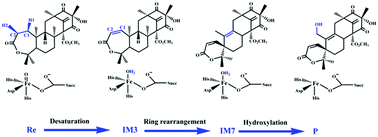Catalytic mechanism of the PrhA (V150L/A232S) double mutant involved in the fungal meroterpenoid biosynthetic pathway: a QM/MM study†
Abstract
PrhA from Penicillium brasilianum and AusE from Aspergillus nidulans are nonheme Fe(II)/α-ketoglutarate-dependent oxygenases, which are involved in the fungal meroterpenoid biosynthetic pathways. Both enzymes use preaustinoid A1 as a common substrate to form divergent products through dynamic skeletal rearrangement. Importantly, structure-guided mutagenesis results in the successful interconversion of AusE and PrhA functions, for example, the PrhA(V150L/A232S) double mutant carried out the same catalysis as AusE. Here, on the basis of the crystal structure of the PrhA (V150L/A232S) double mutant in complex with Fe(II), αKG and the substrate preaustinoid A1, computational models were constructed, and combined quantum mechanics/molecular mechanics (QM/MM) calculations were performed to illuminate the reaction mechanism at the atomistic level. According to our calculation results, the whole reaction occurs on the quintet state surface. All three steps, including desaturation, ring rearrangement and hydroxylation, require three hydrogen abstractions by FeIV![[double bond, length as m-dash]](https://www.rsc.org/images/entities/char_e001.gif) O to trigger the reaction. Owing to the relative position of FeIV
O to trigger the reaction. Owing to the relative position of FeIV![[double bond, length as m-dash]](https://www.rsc.org/images/entities/char_e001.gif) O to the hydrogen atoms in the substrate to be extracted, the three H-abstractions correspond to different energy barriers, which are 17.9, 23.6 and 21.8 kcal mol−1, respectively. For the ring rearrangement, as soon as the H5 is extracted, the skeletal rearrangement is very easy. However, in the hydroxylation of intermediate preaustinoid A3, the final O-rebound corresponds to a high barrier, which is mainly caused by the long distance between the Fe–OH and –CH2 radical. It is the relative orientation of the substrate to the highly reactive FeIV
O to the hydrogen atoms in the substrate to be extracted, the three H-abstractions correspond to different energy barriers, which are 17.9, 23.6 and 21.8 kcal mol−1, respectively. For the ring rearrangement, as soon as the H5 is extracted, the skeletal rearrangement is very easy. However, in the hydroxylation of intermediate preaustinoid A3, the final O-rebound corresponds to a high barrier, which is mainly caused by the long distance between the Fe–OH and –CH2 radical. It is the relative orientation of the substrate to the highly reactive FeIV![[double bond, length as m-dash]](https://www.rsc.org/images/entities/char_e001.gif) O that controls the catalytic chemistry of these enzymes. The reaction barriers are sensitive to the geometry of FeIV
O that controls the catalytic chemistry of these enzymes. The reaction barriers are sensitive to the geometry of FeIV![[double bond, length as m-dash]](https://www.rsc.org/images/entities/char_e001.gif) O⋯Hx (Hx is the hydrogen atom to be extracted). These results may provide useful information for understanding the mechanisms of AusE and PrhA as well as other nonheme Fe(II)/α-ketoglutarate-dependent oxygenases.
O⋯Hx (Hx is the hydrogen atom to be extracted). These results may provide useful information for understanding the mechanisms of AusE and PrhA as well as other nonheme Fe(II)/α-ketoglutarate-dependent oxygenases.

- This article is part of the themed collection: 2019 PCCP HOT Articles


 Please wait while we load your content...
Please wait while we load your content...